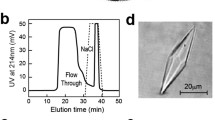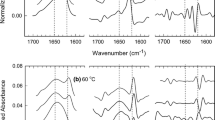Abstract
Fish antifreeze proteins and glycoproteins (AF(G)Ps) prevent ice crystal growth and are able to protect mammalian cells and tissues from hypothermic damage in the sub-zero Polar oceans. This protective mechanism is not fully understood, and further data is required to explain how AF(G)Ps are able to stabilize lipid membranes as they pass through their phase transition temperatures. Solid-state NMR spectroscopy was used as a direct method to study the interaction of the 37-residue α-helical type I AFP, TTTT, and the low molecular weight fraction glycoprotein, AFGP8, with dimyristoylphosphatidylcholine membranes above and below the gel-fluid phase transition temperature. In contrast to previous studies in fluid phase bilayers these experiments have provided direct information regarding both the mobility of the phosphate headgroups and perturbation of the acyl chains at a range of temperatures under identical conditions on the same sample. At 5°C changes in the 2H and 31P spectra and a dramatic increase in the 31P T1 relaxation times were consistent with a significant disruption of the membrane by TTTT. Heating to 30°C appeared to expel the peptide from the lipid and re-cooling showed that the interaction of TTTT was not reversible. By contrast, 31P spectra of the membranes with AFGP8 were consistent with interaction with the phosphate headgroups at both 5 and 30°C. Although both peptides interact with the phospholipid bilayer surface, which may stabilize the membrane at lower temperatures, the longer 31P T1 values and the 2H NMR data obtained for TTTT compared with AFGP8 suggest that TTTT causes a greater reduction of phosphate headgroup mobility and has a greater effect on the lipid acyl chains at 5°C.



Similar content being viewed by others
Abbreviations
- ADP:
-
Ammonium dihydrogen phosphate
- AF(G)P:
-
Antifreeze (glyco)protein
- AFGP8:
-
Low molecular weight fraction
- CSA:
-
Chemical shift anisotropy
- DMPC:
-
1,2-Dimyristoyl-sn-glycero-3-phosphocholine
- DMPC-d 54 :
-
1,2-Dimyristoyl(d 54)-sn-glycero-3-phosphocholine
- FTIR:
-
Fourier transform infra-red
- MLV:
-
Multilamellar vesicles
- MW:
-
Molecular weight
- ss-NMR:
-
Solid-state nuclear magnetic resonance
- TFE:
-
Trifluoroethanol
References
Bonev BB, Lam Y-H, Anderluh G, Watts A, Norton RS, Separovic F (2003) Effects of the eukaryotic pore-forming cytolysin equinatoxin II on lipid membranes and the role of sphingomyelin. Biophys J 84:2382–2392
Cornell BA, Weir LE, Separovic F (1988) The effect of gramicidin A on phospholipid bilayers. Eur Biophys J 16:113–119
Davis JH (1979) Deuterium magnetic resonance study of the gel and liquid crystalline phases of dipalmitoylphosphatidylcholine. Biophys J 27:339–58
DeVries AL (1988) The role of antifreeze glycopeptides and peptides in the freezing avoidance of Antarctic fishes. Compar Biochem Physiol B 90:611–621
Dufourc EJ, Mayer C, Stohrer J, Althoff G, Kothe G (1992) Dynamics of phosphate head groups in biomembranes. Comprehensive analysis using phosphorus-31 nuclear magnetic resonance lineshape and relaxation time measurements. Biophys J 61:42–57
Duman JG, DeVries AL (1974) Freezing resistance in winter flounder Pseudopleuronectus americanus. Nature 247:237–238
Feeney RE (1974) A biological antifreeze. Am Sci 62:712–719
Fletcher GL, Goddard SV, Wu YL (1999) Antifreeze proteins and their genes: from basic research to business opportunity. Chem Tech 29:17–28
Fletcher GL, Hew CL, Davies PL (2001) Antifreeze proteins of Teleost Fish. Annu Rev Physiol 63:359–390
Fourney RM, Joshi SB, Kao MH, Hew CL (1984) Heterogeneity of antifreeze polypeptides from the Newfoundland winter flounder, Pseudopleuronectes americanus. Can J Zool 62:28–33
Graether SP, Slupsky CM, Sykes BD (2006) Effect of a mutation on the structure and dynamics of an α-helical antifreeze protein in water and ice. Proteins Struct Funct Bioinform 63:603–610
Harding MM, Ward LG, Haymet ADJ (1999) Type I ‘antifreeze’ proteins—Structure-activity studies and mechanisms of ice growth inhibition. Eur J Biochem 264:653–665
Harding MM, Anderberg PI, Haymet ADJ (2003) “Antifreeze” glycoproteins from polar fish. Eur J Biochem 270:1381–1392
Hays LM, Feeney RE, Crowe LM, Crowe JH, Oliver AE (1996) Antifreeze glycoproteins inhibit leakage from liposomes during thermotropic phase transitions. Proc Natl Acad Sci USA 93:6835–6840
Hays LM, Feeney RE, Tablin F, Oliver AE, Walker NJ, Crowe LM, Crowe JH (1997) Fish antifreeze glycoproteins protect cellular membranes during lipid-phase transitions. News Physiol Sci 12:189–194
Inglis SR, Turner JJ, Harding MM (2006) Applications of type I antifreeze proteins: studies with model membranes & cryoprotectant properties. Curr Protein Peptide Sci 7:509–522
Lau T-L, Ambroggio EE, Tew DJ, Cappai R, Masters CL, Fidelio GD, Barnham KJ, Separovic F (2006) Amyloid-β peptide disruption of lipid membranes and the effect of metal ions. J Mol Biol 356:759–770
Lewis RNAH, Mak N, McElhaney RN (1987) A differential scanning calorimetric study of the thermotropic phase behavior of model membranes composed of phosphatidylcholines containing linear saturated fatty acyl chains. Biochemistry 26:6118–6126
Lu J-X, Damodaran K, Blazyk J, Lorigan GA (2005) Solid-state nuclear magnetic resonance relaxation studies of the interaction mechanism of antimicrobial peptides with phospholipid bilayer membranes. Biochemistry 44(30):10208–10217
Madura J, Baran K, Wiezerbicki A (2000) Molecular recognition and binding of thermal hysteresis proteins to ice. J Mol Recog 13:101–113
Prenner EJ, Lewis RNAH, Kondejewski LH, Hodges RS, McElhaney RN (1999) Differential scanning calorimetric study of the effect of the antimicrobial peptide gramicidin S on the thermotropic phase behavior of phosphatidylcholine, phosphatidylethanolamine and phosphatidylglycerol lipid bilayer membranes. Biochim Biophys Acta 1417:211–223
Pukala TL, Boland MP, Gehman JD, Kuhn-Nentwig L, Separovic F, Bowie JH (2007) Solution structure and interaction of cupiennin 1a, a spider venom peptide, with phospholipid bilayers. Biochemistry 46:3576–3585
Rubinsky B, Arav A, Mattiolo M, DeVries AL (1990) The effect of antifreeze glycopeptides on membrane potential changes at hypothermic temperatures. Biochem Biophys Res Commun 173:1369–1374
Rubinsky B, Arav A, DeVries AL (1991a) Cryopreservation of oocytes using directional cooling and antifreeze glycoproteins. Cryo-Letters 12:93–106
Rubinsky B, Arav A, Fletcher GL (1991b) Hypothermic protection—a fundamental property of “antifreeze” proteins. Biochem Biophys Res Commun 180:566–571
Seelig J, Seelig A (1980) Lipid conformation in model membranes and biological membranes. Q Rev Biophys 13:19–61
Separovic F, Gawrisch K (1996) Effect of unsaturation on the chain order of phosphatidylcholines in a dioleoylphosphatidylethanolamine matrix. Biophys J 71:274–282
Separovic F, Cornell B, Pace R (2000) Orientation dependence of NMR relaxation time, T1[rho], in lipid bilayers. Chem Phys Lipids 107:159–167
Smith R, Separovic F, Bennett FC, Cornell BA (1992) Melittin induced changes in lipid multilayers: a solid-state NMR study. Biophys J 63:469–474
Tachibana Y, Fletcher GL, Fujitani N, Tsuda S, Monde K, Nishimura S-I (2004) Antifreeze glycoproteins: elucidation of the structural motifs that are essential for antifreeze Activity. Angew Chem Int Ed 43:856–862
Tomczak MM, Crowe JH (2002) The interaction of antifreeze proteins with model membranes and cells. In: Ewart KV, Hew CL (eds) Fish antifreeze proteins, vol 1, pp 187–212
Tomczak MM, Hincha DK, Estrada SD, Feeney RE, Crowe JH (2001) Antifreeze proteins differentially affect model membranes during freezing. Biochim Biophys Acta 1511:255–263
Tomczak MM, Hincha DK, Estrada SD, Wolkers WF, Crowe LM, Feeney RE, Tablin F, Crowe JH (2002a) A mechanism for stabilization of membranes at low temperatures by an antifreeze protein. Biophys J 82:874–881
Tomczak MM, Vigh L, Meyer JD, Manning MC, Hincha DK, Crowe JH (2002b) Lipid unsaturation determines the interaction of AFP type I with model membranes during thermotropic phase transitions. Cryobiology 45:135–142
Tomczak MM, Hincha DK, Harding MM, Haymet ADJ, H. CJ (2003) The effect of hydrophobic analogues of the type I winter flounder antifreeze protein on lipid bilayers. FEBS Lett 551:13–19
Van Geet AL (1970) Calibration of methanol nuclear magnetic resonance thermometer at low temperature. Anal Chem 42:679–680
Yang DSC, Sax M, Chakrabartty A, Hew CL (1988) Crystal structure of an antifreeze polypeptide and its mechanistic implications. Nature 333:232–237
Yeh Y, Feeney RE (1996) Antifreeze proteins—structures and mechanisms of function. Chem Rev 96:601–617
Acknowledgments
Financial support from the Australian Research Council Discovery Grant Scheme is gratefully acknowledged. SRI would like to thank Dr. John Gehman, University of Melbourne, for advice in setting up the ss-NMR experiments.
Author information
Authors and Affiliations
Corresponding authors
Rights and permissions
About this article
Cite this article
Garner, J., Inglis, S.R., Hook, J. et al. A solid-state NMR study of the interaction of fish antifreeze proteins with phospholipid membranes. Eur Biophys J 37, 1031–1038 (2008). https://doi.org/10.1007/s00249-008-0339-3
Received:
Revised:
Accepted:
Published:
Issue Date:
DOI: https://doi.org/10.1007/s00249-008-0339-3




